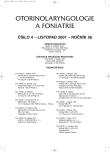Cochlear and Brainstem Implantation in Adult Patients - Results
Authors:
L. Černý 1; J. Skřivan 2
Authors‘ workplace:
Foniatrická klinika 1. LF UK a VFN, Praha
; přednosta doc. MUDr. O. Dlouhá, CSc.
Klinika ORL a chirurgie hlavy a krku 1. LF UK a FN Motol, Praha
1; přednosta prof. MUDr. J. Betka, DrSc.
2
Published in:
Otorinolaryngol Foniatr, 56, 2007, No. 4, pp. 191-194.
Category:
Original Article
Overview
More than 100 adult patients were implanted in the Czech republic till now and the number has been growing rapidly in the last 6 years. The results of retrospective study of all adult patients (N=46, mean age 40.1 y.) implanted in our implant centre in years 2000-2004 and rehabilitated in 2001-2006 are presented. There were used both cochlear implant (N=43) and brainstem implant system (N=3) by Cochlear Nucleus type 22 and 24, all of them unilaterally.
The aim of the study was to obtain an overview of results in correlation with pre-operative predictive factors as duration of severe hearing loss, lip-reading ability and age of patients.
There were evaluated 100% of cases from the 5-year period. A detailed patient history was obtained, pre-operative and post-operative examination by pure tone audiometry, lip-reading ability by a video-test, tests of speech understanding (open-set and closed-set word identification – CWA Czech Word Audiometry in a free field) and quality of life assessment (adapted from International Outcome Inventory). The results were obtained during periodical examinations (at least 1 year after the implantation).
The results were compared in 4 groups:
brainstem implant systems (N=3, mean age 32.3 y.), cochlear implants in long-term-progressive hearing loss (N=18, mean age 37.6 y., onset of severe hearing loss in childhood, well-developed-speaking patients only), cochlear implants in sudden deafness (N=14, mean age 43.6 y., duration of hearing loss under 5 years – due to meningitis, antibiotics, trauma) and cochlear implants in patients in older age (N 6, mean age 62.6 y., patients over 59 years only, both long-term-progressive and sudden deafness together).
Based on our results we can see no risk of a worse post-operative performance in people older than 59 years (N=6, mean age 62.6 y.). There are better results in speech-understanding without lip-reading and subjective satisfaction than in other groups. Also the results of patients with long-term-progressive hearing loss (N=18, mean age 37.6 y.) are fully comparable with the mean results of all-cochlear-implanted group (N=43).
Key words:
cochlear implant, auditory brainstem implant, predictors, post-operative performance.
Sources
1. Cox, R. M., Stephens, D., Kramer, S. E.: Translations of the International Outcome Inventory for Hearing Aids (IOI-HA). International Journal of Audiology, 41, 2002, 1, s. 3-26.
2. van Dijk, J. E. et al.: Predictors of cochlear implant performance. Audiologie, 38, 1999, s. 109-116.
3. Hogan, A., Hawthorne, G., Kethel, L. et al.: Health-related quality-of-life outcomes from adult cochlear implantation: a cross-sectional survey. Cohlear Implants International, 2001, 2, s. 73-85.
4. Nevison, B. et al.: Results from a European Clinical Investigation of the nucleus multichannel auditory brainstem implant. Ear and Hearing, 23, 2002, s. 170-183.
5. Novák, A.: Audiologie. Vyšetřovací technika, diagnostika, léčba a rehabilitace. Praha, Unitisk, 2003. 333 s.
6. Novák, A., Veldová, Z., Jiránková, D.: První zkušenosti s rehabilitací nemocných po kochleární implantaci. Čs. Otolaryng., 38, s. 244-251.
7. Seeman, M. a kol.: Česká slovní audiometrie. SZN, Praha, 1960, 166 s.
8. Skřivan, J.: Prediktivní faktory kochleární implantace. Kandidátská dizertační práce. 1. lékařská fakulta UK v Praze, 2001.
9. Vymlátilová, E., Příhodová, J., Šupáček, I., Doubnerová, M., Kabelka, Z.: Faktory ovlivňující využití kochleárního implantátu u dětí. Otorinolaryng. a Foniat. /Prague/, 48, 1999, č. 3, s. 131-134.
Labels
Audiology Paediatric ENT ENT (Otorhinolaryngology)Article was published in
Otorhinolaryngology and Phoniatrics

2007 Issue 4
Most read in this issue
- Beta-hemolytic Streptococci of Serological Group C and Acute Tonsillopharyngitis. Epidemiologic Study
- Pain in the Head and Neck Region - Arthritis of the Temporomandibular Joint
- Chronic Rhinosinusitis with Nasal Polypi and Staphylococcus aureus
- Amyloidosis of Upper Respiratory and Swallowing Pathways
